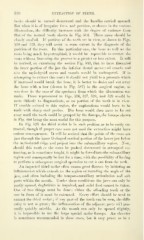Page 612 - My FlipBook
P. 612
6'iO EXTRACTION OF TEETH.
beaks should be turned downward and the handles carried upward.
But when it is of irregular t'onn and position, as shown in the various
illustrations, the difficulty increases with the degree of variance from
that of the normal tooth shown in Fig. 514. These cases should be
closely studied. If })ortions of the teeth are in view, as shown in Figs.
530 and o31, they will assist to some extent in the diagnosis of the
position of the roots. In this particular case, the bone as well as the
roots being much hypertrophied, it would be impossible to extract the
roots without fracturing the process to a greater or less extent. It will
be noticed, on examining the section Fig. 530, that to have fractured
the inner portion of the jaw the inferior dental nerve and vessels and
also the mylo-hyoid nerv^e and vessels would be endangered. If in
attempting to extract this tooth it should not yield to a pressure which
if increased would break the bone, it is better to desist and cut away
the bone with a bur (shown in Fig. 587) in the surgical engine, as
was done in the case of the specimen from which the illustration was
made. Those represented in Figs. 526, 527, 528, and 529 would be
more difficult to diagnosticate, as no portion of the teeth is in view.
If trouble existed in this region, the explorations would have to be
made with sharp steel probes. The bone would then have to be cut
away until the tooth could be grasped by the forceps, the forceps shown
in Fig. 488 being the most useful for this purpose.
In Fig. 525 the third molar is in such position as to be easily ex-
tracted, though if proper care were not nsed the extraction might have
.serious consequences. It will be noticed that the points of the roots are
just through the inner U-shaped cortical portion of the lower jaw below
the mylo-hyoid ridge and project into the submaxillary region. Now,
should this tooth or the roots be pushed downward in attempted ex-
tracting, as is sometimes taught, it might be forced into the submaxillary
region and consequently be lost for a time, with the possibility of having
to perform a subsequent surgical operation to cut it out from the neck.
An impacted third molar often causes great distress by initiating an
inflammation which extends to the region surrounding the angle of the
jaw, and often including the temporo-maxillary articulation and soft
parts within the mouth. Under these conditions the jaws can only be
partly opened, deglutition is impaired, and solid food cannot be taken.
One of two things must be done : either the offending tooth or the
one in front of it must be extracted. Every effort should be used to
extract the third molar ; if any part of the tooth can be seen, the diffi-
culty is not so great ; the inflammation of the adjacent parts will gen-
erally quickly subside. As the mouth can only be opened slightly,
it is impossible to nse the large special molar forceps. An elevator
is sometimes recommended in these cases, but it may prove to be a


